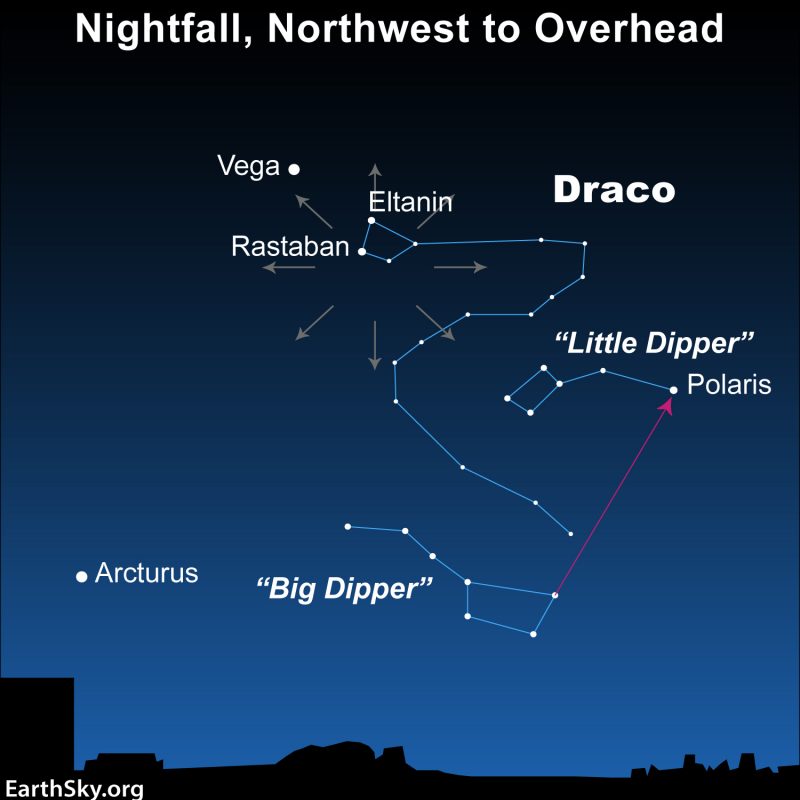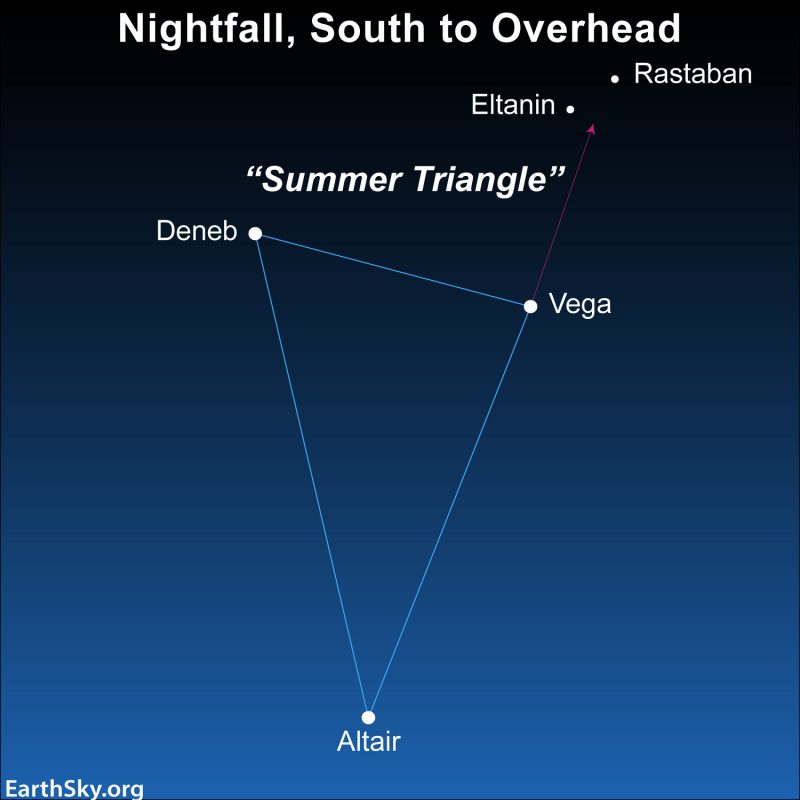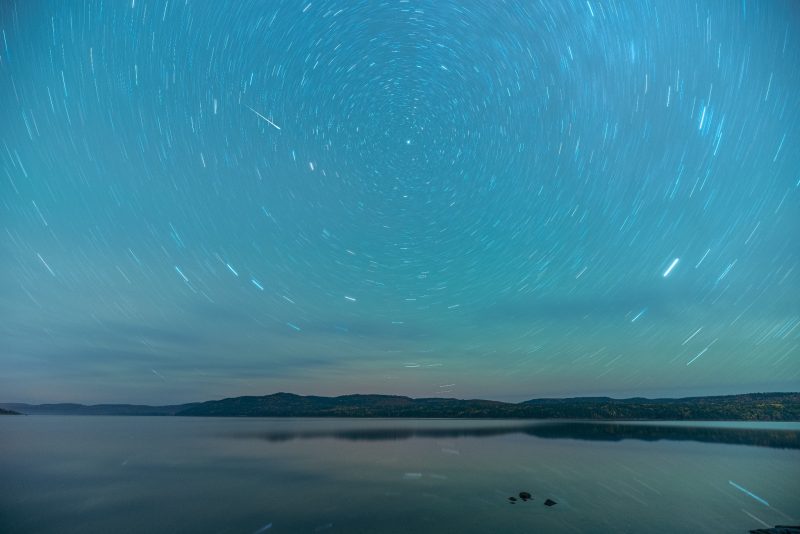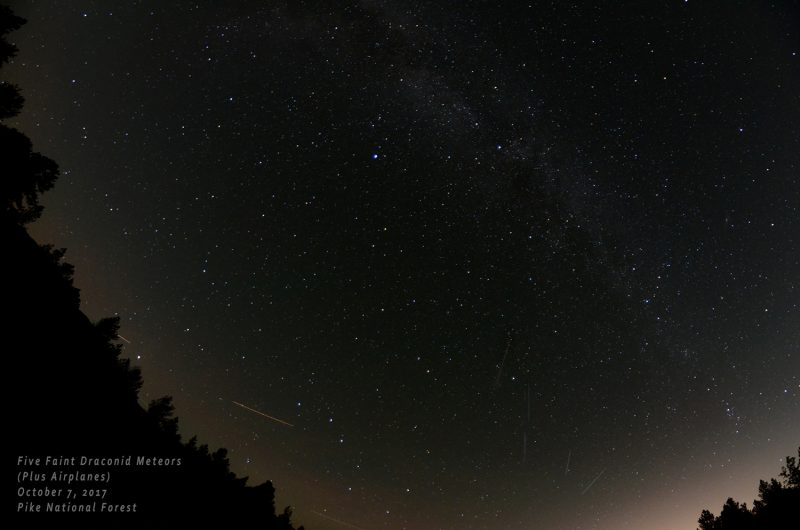
The Draconid shower – also called the Giacobinids – is a real oddity, in that its radiant point stands highest in the sky as darkness falls. That’s why you’ll see more Draconids in the evening hours than in the morning hours after midnight.
Predicted peak: The peak is predicted** for 3 UTC on October 8, 2024.
When to watch: The best time to watch the Draconids in 2024 is the evening of October 7 through the wee hours of the morning on October 8. The waxing crescent moon (27% illuminated) will set before 9 p.m. your local time. So you can watch for meteors in a moonless sky.
Overall duration of shower: October 6 through 10.
Radiant: Highest in the sky in the evening hours. See chart below.
Nearest moon phase: First quarter moon is 18:55 UTC on October 10.
Expected meteors at peak, under ideal conditions: Under a dark sky with no moon, you might catch 10 Draconid meteors per hour.
Note: The Draconid shower is a real oddity, in that the radiant point stands highest in the sky as darkness falls. That means that, unlike many meteor showers, more Draconids are likely to fly in the evening hours than in the morning hours after midnight. This shower is usually a sleeper, producing only a handful of languid meteors per hour in most years. But watch out if the Dragon awakes! In rare instances, fiery Draco has been known to spew forth many hundreds of meteors in a single hour. That possibility keeps many skywatchers outside – even in moonlight – during this shower.
Be sure to watch in a dark sky
Report a fireball (very bright meteor) to the American Meteor Society: it’s fun and easy!
The Draconids’ parent comet
From the late, great Don Machholz (1952-2022), who discovered 12 comets:
The Draconids meteor shower’s parent comet, the object responsible for the dust we see burning up in our atmosphere, is the small periodic comet 21P/Giacobini-Zinner. Michel Giacobini visually discovered this comet on December 20, 1900, in the evening sky, from the Nice Observatory in France. The comet was faint and in the southern part of the constellation Aquarius. Giacobini was using a 46-centimeter (18-inch diameter lens) refractor telescope, the largest telescope for comet hunting at the time. Though the comet is periodic – with a 6.6-year orbit around the sun – observers missed it at its next return. Then, on October 23, 1913, Ernst Zinner of Germany found the comet while looking at variable stars. This was his only comet discovery.
Comet 21P/Giacobini-Zinner comes about as close to the sun as does Earth. Then it ventures back just past the orbit of Jupiter before returning 6.6 years later. The International Cometary Explorer visited it in September 1985, making it the first comet to be visited by a space probe.
Draconid meteor storms
The debris from the comet is not scattered uniformly around its orbit. Much of it is still bunched near the comet. Therefore, when the comet comes back into our neighborhood, it can produce a spectacular meteor shower, known as a meteor storm: hundreds or even thousands of meteors per hour. This happened in 1933 and 1946, with several thousand meteors an hour. In the years 1985, 1998 and 2018, it produced increased counts but not meteor storms. European observers saw over 600 meteors per hour in 2011.
The last perihelion of the comet was September 10, 2018. On that same night, Comet 21P/Giacobini-Zinner came closer to Earth than it had in 72 years. Consequently, the Draconids had an outburst in 2018. See photos of the comet as it swept safely past.
Because this comet has an orbital period of nearly seven years, the next perihelion won’t come until 2025. So we’re not expecting an outburst this year. But, then, no one really knows for sure.

Where is the radiant point?
The radiant point for the Draconid meteor shower is near the stars Eltanin and Rastaban, in the head of the constellation Draco the Dragon in the northern sky. Its far-north location is why the Draconids are best viewed from the Northern Hemisphere. See the two charts above.
The Draconids are best in the evening, because the winged Dragon, the shower’s radiant point, flies highest in the October sky at nightfall. As night passes – no matter where you are on Earth – the radiant point sinks lower in your sky.
You don’t have to locate Draco the Dragon to watch the Draconids. These meteors fly every which way through the starry sky. But finding Draco is fun and relatively easy. The two charts above show you two easy ways to find it. You can star-hop either from the Big Dipper or from the Summer Triangle.
Draconid meteor shower has a rich history
Astronomers in the early 20th century speculated that meteors and comets were related. So of course they tried to link various comets to the spectacular showers of meteors that sometimes rain down in Earth’s sky.
Comet 21P/Giacobini-Zinner was a particularly tempting object about which to make predictions. Remember, it returns every 6.6 years, and its closest point to the sun is about the same as Earth’s distance.
And Comet Giacobini-Zinner didn’t disappoint the astronomers.
The relationship between 21P/Giacobini-Zinner and its meteors – so studied and discussed among professional astronomers in the early 20th century – probably explains why the Draconid meteor shower sometimes goes by the name Giacobinids.
For a taste of history related to this shower, go to the Astronomy Abstract Service from the Smithsonian and NASA. Find a 1934 article called The Meteors from Giacobini’s Comet by C.C. Wylie. It’s an account of the famed meteor storm of 1933.
Draconid meteor shower from the Southern Hemisphere?
It’s possible to view the Draconids from the Southern Hemisphere. But if you’re so far south that the radiant point in the constellation Draco doesn’t rise above your horizon, or rises only briefly, you won’t catch many.
As seen from the Southern Hemisphere, you would have to be rather close to the equator in order to see Draco’s stars. Suppose you live in northern Australia – say Darwin, Northern Territory, Australia – which is at 12 degrees south latitude. If so, you’d be able to see the stars Rastaban and Eltanin very close to your north-northwestern horizon at nightfall in early October (given an unobstructed northern horizon). These stars would set fairly early in the evening. And so you wouldn’t see the head of Draco again until nightfall the following evening.
Why early evening? It’s because, no matter where you live worldwide, the head of Draco reaches upper transit (highest point in your sky) at around 5 p.m. your local time in early October.
Thus, from latitudes in the Southern Hemisphere – even those as far north as northern Australia – you’d have a very narrow window for seeing meteors. If you’re in the Southern Hemisphere, and you’re really wanting to see a Draconid, try looking as soon as it gets really dark on October 7 and 8. And don’t expect much.
Draconid meteor photos from the EarthSky community


Bottom line: In 2024, the Draconid meteor shower – also called the Giacobinids – will probably produce the most meteors on the evening of October 7 and through the early hours of October 8.
*Predicted peak times and dates for meteor showers are from the American Meteor Society. Note that predictions for meteor shower peak times may vary. Back to top











